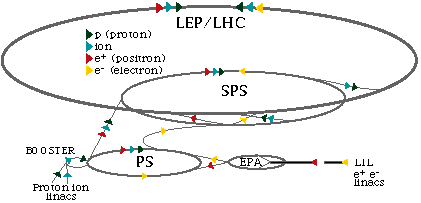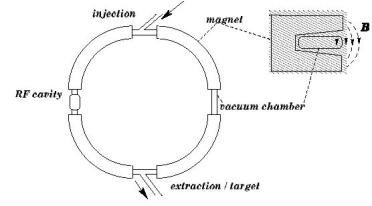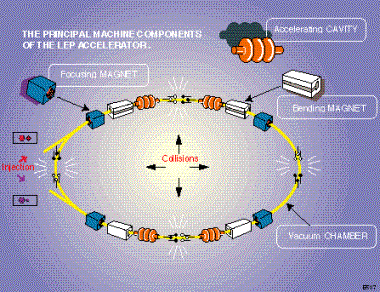CERN
brochures:
Information
booklet for teachers (students aged 16-19 years)
WG
Leader: Antonella del Rosso
ACCELERATO
Particle accelerators are used to investigate the structure of subatomic particles.
The motivation to strive for higher energy came from quantum mechanics, which describes particles as waves whose length is related to the momentum of particle by de Broglie’s expression:
![]()
Higher momentum brings shorter wavelengths and the capability to reveal the structure of matter with more details.
Discovery of
smaller particles reveals more massive particles, which require, according to
Einstein’s
![]() , more and more energy to produce them.As particles are accelerated to energies
many times their rest mass, momentum and energy will be calculated in terms of
the special relativity. Although velocity saturates asymptotically – always
below the speed of light-, momentum and energy continue to increase as particles
are accelerated.
, more and more energy to produce them.As particles are accelerated to energies
many times their rest mass, momentum and energy will be calculated in terms of
the special relativity. Although velocity saturates asymptotically – always
below the speed of light-, momentum and energy continue to increase as particles
are accelerated.
CERN’s accelerator complex, one of the world’s complex scientific instruments, includes particle accelerators and colliders and handles beams of electrons, positrons, protons, antiprotons and ions. The achieved energies are about 100GeV in the Large Electron-Positron Collider LEP2, and will increase up to 7TeV in the future Large Hadron Collider LHC.

Fig.1 CERN’s accelerators complex
As a basic principle, accelerators use powerful electric fields to push energy into a beam of charged particle. According to Lorentz force:
![]()
one can see that particles gain energy only due to the electric field. Particles acquire an energy which is just their charge multiplied by the electric potential difference.
But, building up high-voltage electrostatic generators creates many difficulties because of the electrical breakdown, which becomes a serious problem above a few tens of KV.
The idea of overcoming the voltage breakdown problem of a single stage of acceleration was to place a series of cylindrical electrodes one after another in a straight line to form linear accelerators, called LINACs, and use an alternative field.

Charged particles enter on the left and are accelerated towards the first drift tube by an electric field. Once inside the drift tube, they are shielded from the field and drift through a constant velocity. When they arrive, at the next gap, the field accelerates them again until they reach the next drift tube. This continues with the particles picking up more and more energy in each gap, until they shoot out of the accelerator on the right. The drift tubes shield the particles for the length of time that the field would be decelerating.
But, to reach high energy, it would require extremely long linear accelerators.
The following step was the cyclotron invention (1929), based on making a particle follow a circular path in a magnetic field through the same accelerating gap.
The balance between centripetal acceleration of motion in a circle and Lorentz’s force is:

The radius of the orbit in cyclotron is proportional to the velocity and the frequency of revolution:
![]()
A radio frequency generator excites particles with an electric alternating field of constant frequency. The electric field oscillates at the particle’s circulation frequency.
For low energy particles, the revolution frequency of cyclotron is constant as far as the particle mass remains into the classic limit.
But, as momentum and energy increase and the velocity of a particle approaches that of light, then the velocity begins to increase less rapidly than the particle mass, so the revolution frequency drops so that particles are no longer synchronous with the accelerating potential.
The discovery of the synchrotron principle opened the way to the series of circular accelerators, which are used up, to the present day.
A short pulse of particles is injected at low magnetic field, the field rises in proportion to the momentum of particles as they are accelerated and this ensures that the radius of the orbit remains constant.
The accelerated particles take less and less time to complete their orbit so the frequency of the accelerating alternative current must increase as well.

Fig.3
Synchrotron basic scheme
Charged
particles receive the energy needed to reach a speed close to that of light from
accelerating cavities, which store up electric energy, transferring a small
amount to the particles each time they pass. They act like a short section of
linear accelerator. Several radio-frequency (rf) cavities are positioned around
the ring. These contain the alternating electric field synchronized with the
beam’s orbital period, and accelerate the charges.
Dipole
magnets keep the particles moving in a circle. Whenever a charged particle is
swung in a circle it radiates energy. The greater its centripetal acceleration
the greater the rate of radiation, so high-energy electrons in circular
accelerators lose a lot of energy as synchrotron radiation.

Fig.
4 Synchrotron radiation emitted by an accelerated charged particle
The
opening angle depends on 1/g,
where g
is the gamma factor
 , so the higher energetic are particles, the smaller will be this angle. The
radiated power depends on
, so the higher energetic are particles, the smaller will be this angle. The
radiated power depends on
![]() and curvature of the path. This
must be pumped into the beam through the rf cavities. The LEP radius of about
3,1km is designed to ensure a smooth bending of particle beam to avoid energetic
losses.
and curvature of the path. This
must be pumped into the beam through the rf cavities. The LEP radius of about
3,1km is designed to ensure a smooth bending of particle beam to avoid energetic
losses.
The
radiation losses in electron-positron accelerators are much bigger than in
proton-antiproton accelerators. The mass of electron is roughly 2000 times
smaller than that of the proton, and therefore, for the same energy it has a g,
that is 2000 times larger. The radiated power depends on
![]() , so there are necessary powerful rf systems and much of the voltage per turn,
U, to keep the beam from decelerating.
, so there are necessary powerful rf systems and much of the voltage per turn,
U, to keep the beam from decelerating.
Table
1. Comparison between the colliders’ parameters. The particle energies,
collider’s radius, number of particles per bunch, the necessary voltage per
turn and radiated power are given in the column for each type of collider
|
|
E
(GeV) |
R
( km) |
N
(1012) |
U
(MeV) |
P
(MW) |
|
LEP1
(1989) |
45 |
3.1 |
260 |
260 |
2.1 |
|
LEP2
(1995) |
100 |
3.1 |
2800 |
2800 |
23 |
|
LHC |
7000 |
3.1 |
0.007 |
0.007 |
0.005 |
So,
each time more energy is pumped into the particles, the magnetic field has to be
increased to prevent them for skidding of the ring.
Focusing
quadrupole magnets are used to keep the particles tightly packed within the
beam. They work in much the same way as lenses do with light. Effective focusing
is very important as it enhances the beam intensity and reduces the beam
cross-section.
The
particle beam travels inside a pipe, from which the air has been removed in
order that particles collisions with molecules of air to be avoided. Beam
stability depends on the vacuum chamber geometry.
Large
particle colliders are used to accelerate particles to very high energies. If
the incoming particles are simply slammed into a stationary target, much of the
projectile energy is taken up by the target’s recoil and not exploitable. Much
more energy is available for the production of new particles if two beams
traveling in opposite directions are collided together.
The
energy of interest to produce new particles in different collisions is Ecm,
the enrgy in the center-of-mass frame. In the case of colliders, Ecm=2Ep,
where Eb means the energy of one incident particle.
The
electron-positron accelerator LEP is a collider. Electrons and positron
circulated in opposite directions in the same guide field, being equal in mass
but opposite charge, appeared to the magnetic bending and focusing fields as
identical currents, one bent to the left, the other to the right. Another CERN
collider, the Super Proton Synchrotron (SPS) uses the same technique to
circulate protons in one direction and anti-proton in the opposite direction.

Fig.4
Basic scheme of LEP collider
Bunches
of particles are focused down to the thickness of a hair and made to collide.
Each bunch contains more than 1011 (see Table 1), but on average only
one in about 40000 collisions between the bunches produces the desired effect-a
head-on electron-positron collision. To increase the probability of these
events, bunches are made to circulate several hours into the ring.
The
LEP2 collider at CERN was until 1999 the largest particle collider in the world,
accelerating bunches of electrons and positrons to the energies needed to
produce pairs of charged carriers of the weak force W+ and W-
particles. Detection of Z0s and Ws, allowed the LEP experiments to
make precise tests of the Standard Model of particles and their interactions.
The
Large Hadron Collider LHC is designed to accelerate hadrons in experiments
probing beyond the Standard Model, more precisely, addressing the following
topics: the origin of the particle masses, unification of strong, weak,
electromagnetic gauge interaction, and the quarks flavour. LHC machine will
share the 27-kilometre LEP tunnel, and will use the most advanced
superconducting magnets and accelerators technologies. The magnitude of the
magnetic field will be B=8,4T, at a current of 11700 A and temperature of
T=1,9K.
References:
1.E.J.N.
Wilson, “An Introduction to Particle Accelerators”, Oxford University Press,
2001
2.
O. Bruning, Accelerators, In: Summer Student Lecture Program, CERN,
Geneva, Switzerland, 2002